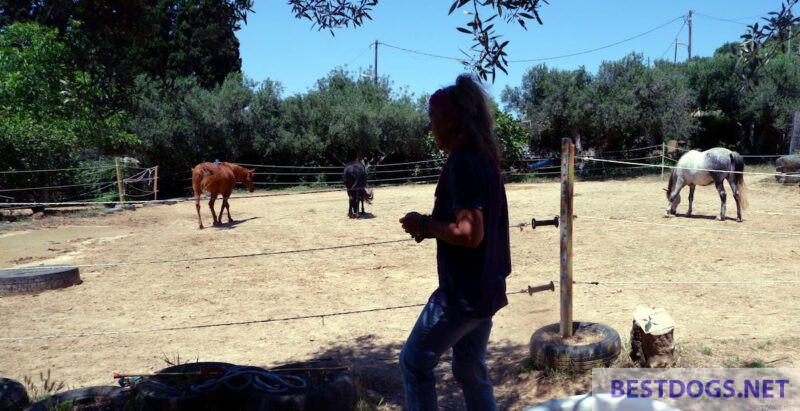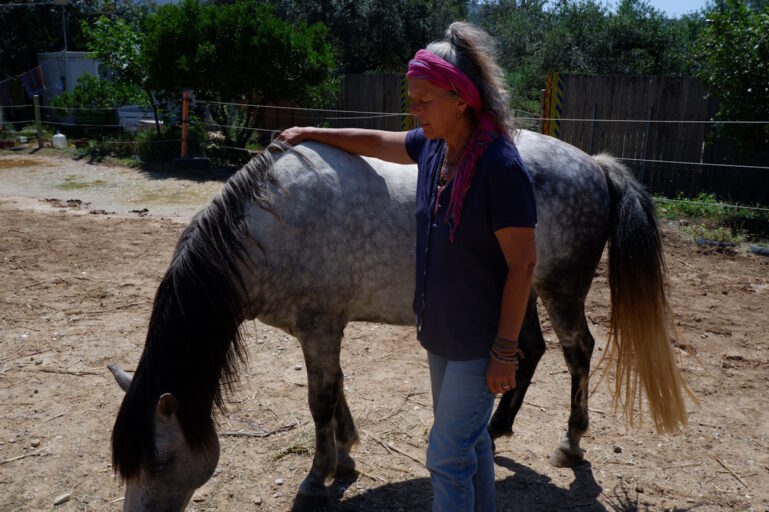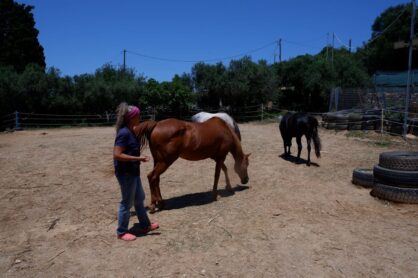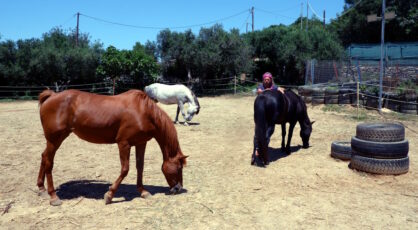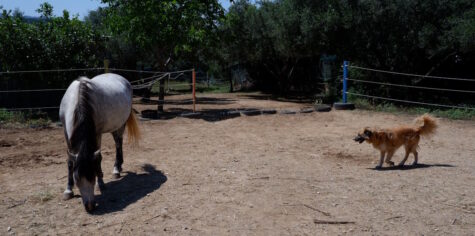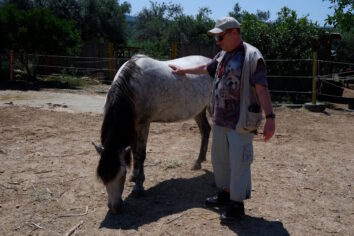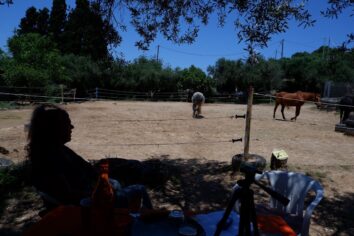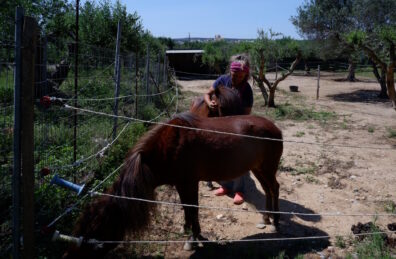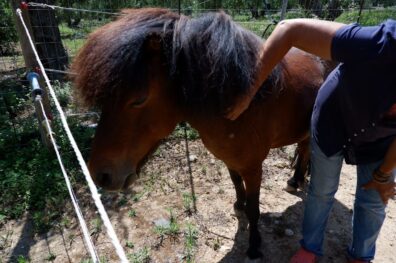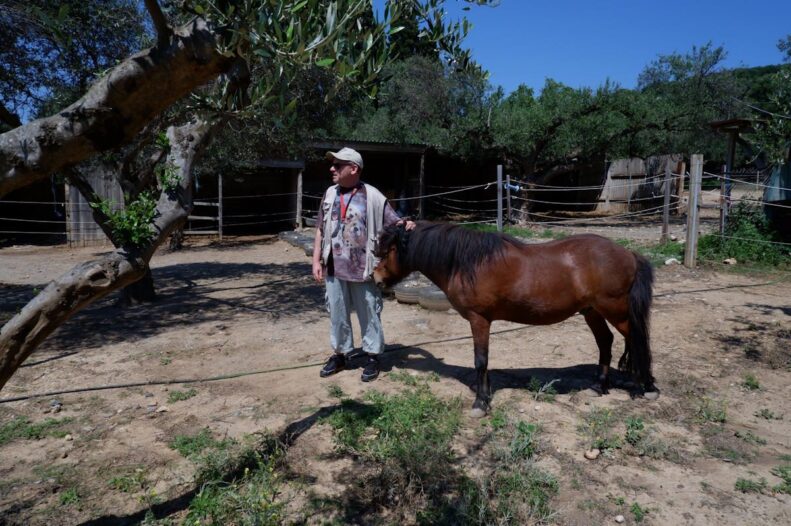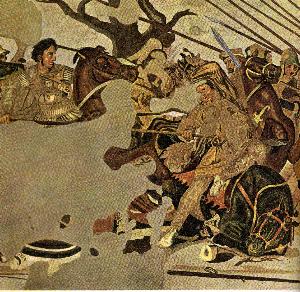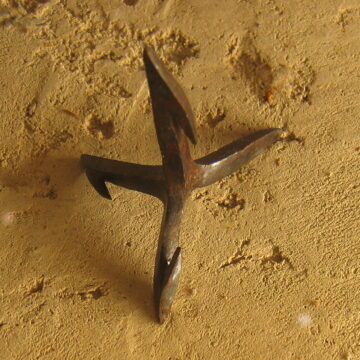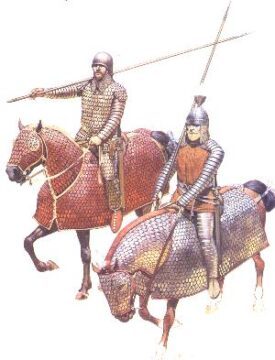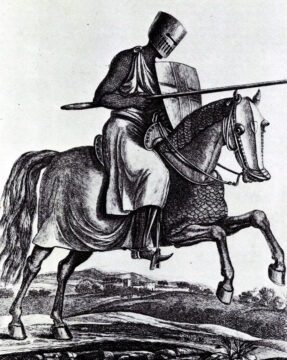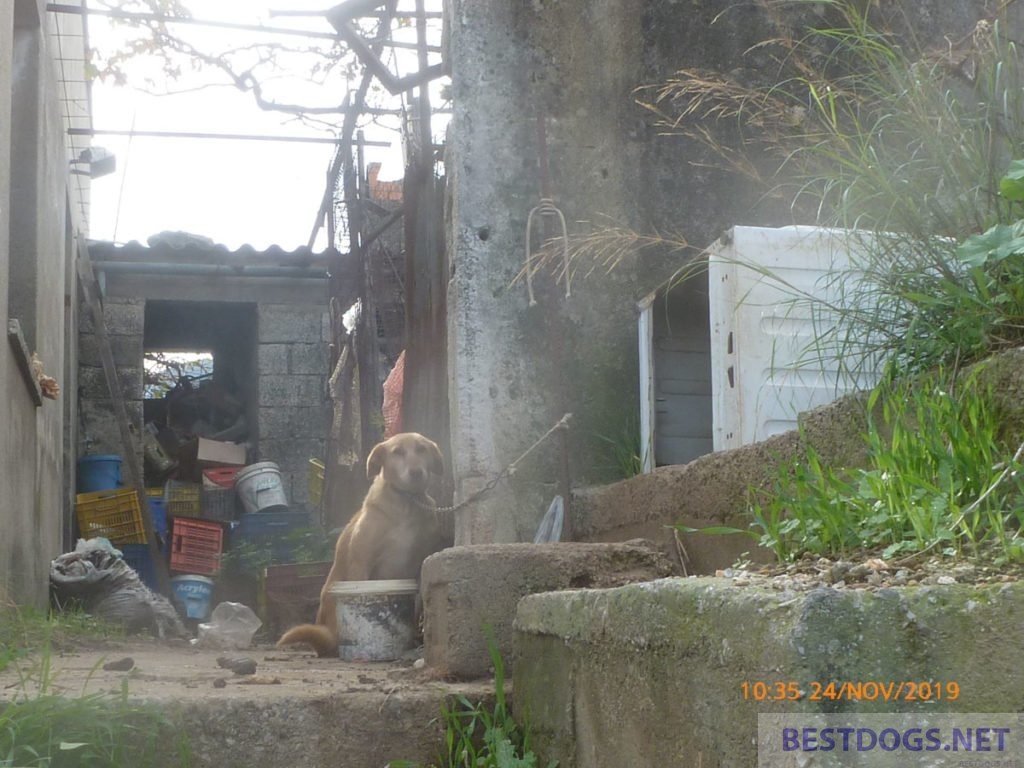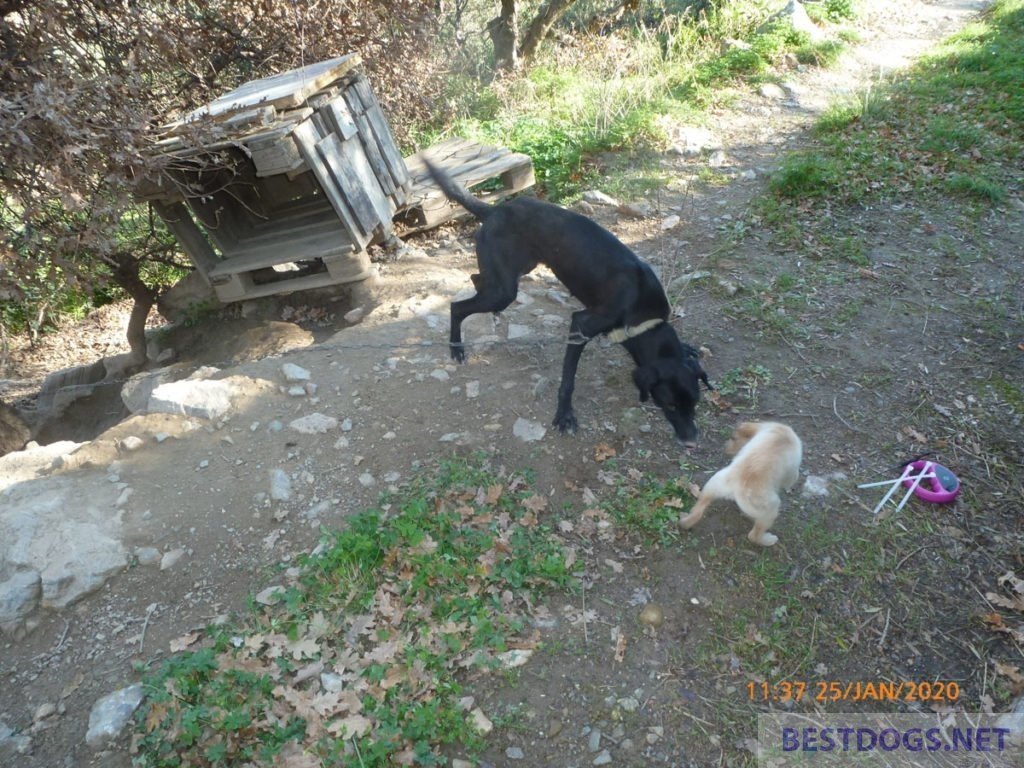‘With horses in the here and now’ near Sitia in eastern Crete.
Educational and therapeutic use of horses of ancient Greek breeds in Crete.
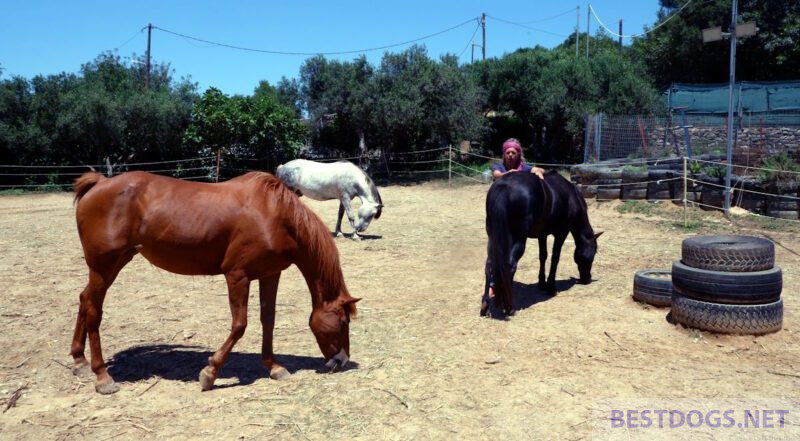
With horses in the here and now
Table of Contents
Not far from picturesque Sitia in eastern Crete, about 1.5 miles south along the road to Ierapetra (in the village of Piskokefalo turn east to the next village Kato Episkopi, there in front of the church clearly standing out again to the right to the end of the village) is the horse club of the ‘Friends of with horses in the here and now‘ of Andrea Patrizia Wiener-Angelakis.
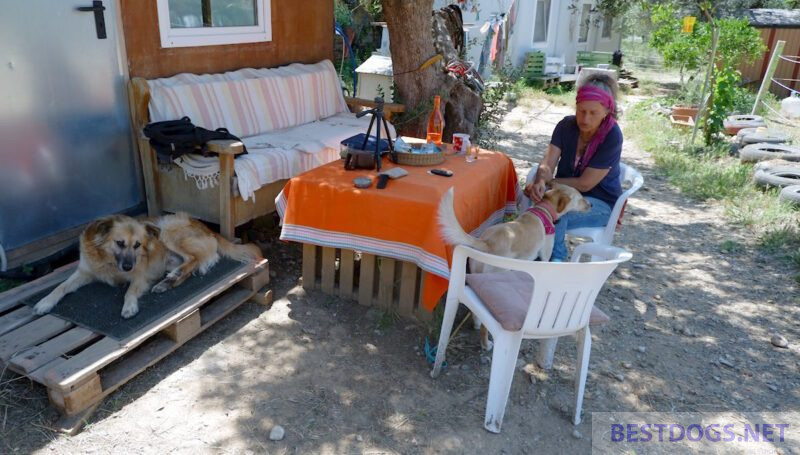
With two dogs and currently three horses of ancient Greek breeds, as well as two specimens of the rare Skyros ponies (which originally came from Corfu from a project for the preservation of the breed there) Andrea lives on the farm all year round (but it closes at 7 pm for visitors).
All horses are also not shod with horseshoes (see the section on the myth of horseshoes below).
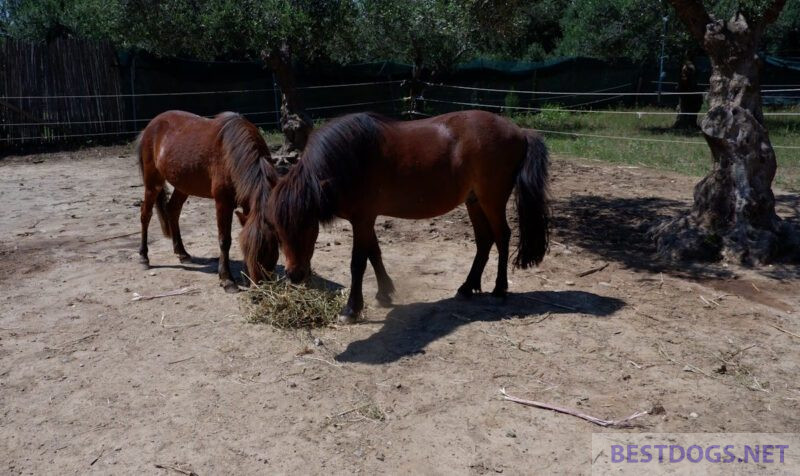
Body language with horses (video)
The daily training can be seen in the horses, with which she can communicate in an amazing way with the help of body language, as can be seen beautifully in the following video:
The association supports the educational and therapeutic use of horses. This includes mainly ‘groundwork‘, but also riding lessons and riding. Groundwork means that you do not get on the horse and ride, but first learn how to deal with him from the ground at ‘eye level’.
To take courses or lessons with Andrea and her friends, no previous experience with horses is necessary, because the first steps are learned through ‘groundwork’.
Therefore, she is happy about all visitors and of course tourists, who would like to learn the right way to handle their beautiful Greek horses on Crete.
In addition, individual one-on-one training with overnight accommodation is offered. Besides, there are also events like yoga, parties and dance evenings, all together with or at the horses. From time to time, there are also seminars and workshops with qualified professionals and trainers.
These events are always announced in advance on the Facebook page of Association of friends with Horses in Here & Now.
Body language through interaction with horses
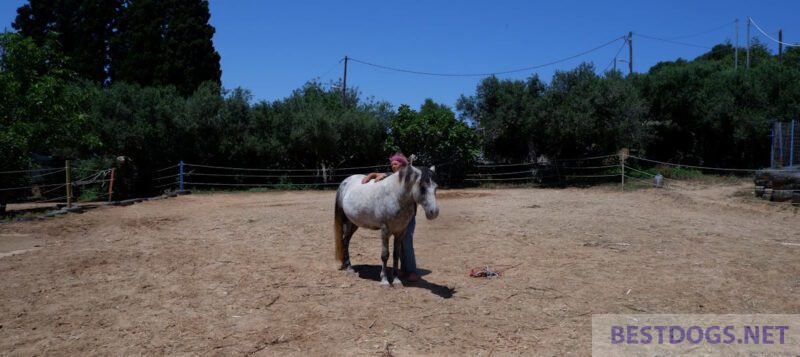
The horses are trained to help children and adults – of all ages and also with disabilities – to acquire more self-confidence, which increases confidence in their own abilities and makes it easier to cope with difficult situations in life.
Because horses are herd animals, they communicate through body language. Horse language within the herd takes place with movements, gestures, sounds, signs and touch. Thus, the majority of this ‘language’ consists of body language. For example, the horse’s facial expression, ear position, movements with the tail and certain postures clearly reveal to the other members of the herd how he is doing and how one should behave towards him at that moment. This can already be seen from a distance.
In addition, there is communication through the positioning in space to each other, for example frontally or parallel and also through the direction of movement to each other. Because the horse must be able to judge instinctively fast, in order to decide whether something is dangerous in its environment and whether it is necessary to flee.
Since the oldest language for humans is also body language and this is still true for our young children, Andrea’s visitors should be able to rediscover this here, because much of it was lost along with the learning of verbal language and the beginning of school.
The clear intentions should therefore be expressed or reinforced through body language. By developing or learning natural leadership qualities based on trust, a sense of responsibility and team spirit with the horses can have quite a positive effect on everyday life.
Since horses always live in the present – fully ‘in the here and now’ – humans can heighten their awareness of the moment, making them less likely to hope just for the future or mourn the past.
The goal of Andrea, her friends and horses is to create a world of harmony, compassion and togetherness with the help of their excellent horse work, in which animal welfare is also an important part. Because this is what her horses teach us, who live contentedly ‘in the here and now’.
More photos from the visit at Andrea
Contact and directions
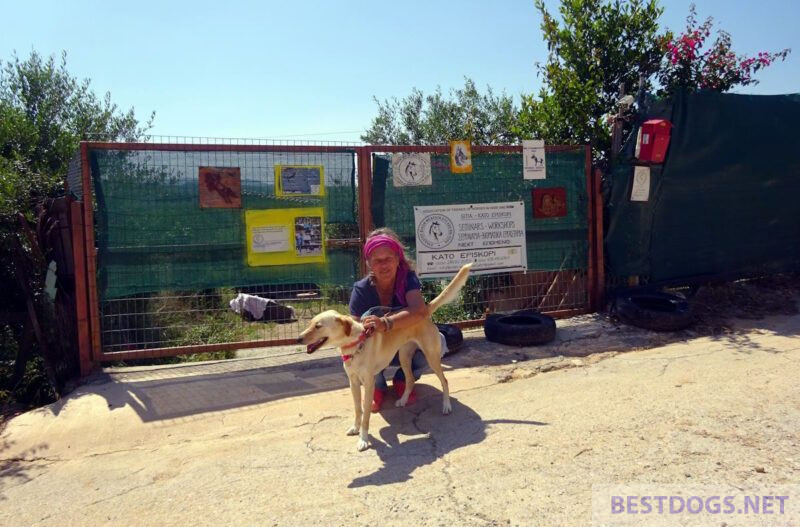
Association of the Friends of ‘With Horses in the Here and Now’, Eastern Crete
Andrea Patrizia Wiener-Angelakis
Kato Episkopi (72300 Sitia, Crete)
Phone ++30 698 190 6761
Email: [email protected]
Facebook: https://www.facebook.com/Association.of.friends.with.Horses.in.Here.and.Now
Website: https://me-aloga-sto-edo-kai-tora.blogspot.com/
Please contact here by phone before visiting (before 7pm)!
Donations in kind or money are gladly accepted to support the association and farm!
Bank details for donations:
Eurobank
Account holder: Association of friends of With horses in the Here and Now
IBAN: GR 4202601710000690200498798
SWIFT code: ERBKGRAAXXX
Link to Directions Horse Association near Sitia.
Approach:
In the village of Piskokefalo, about 1 mile south of Sitia on the road towards Ierapetra, turn left here:
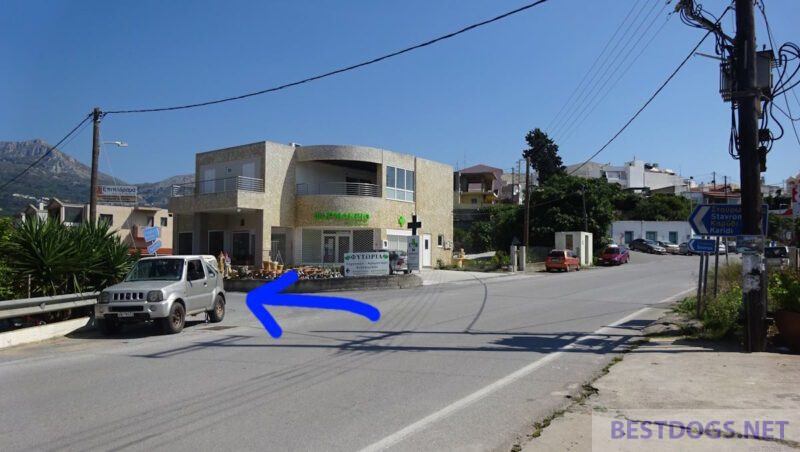
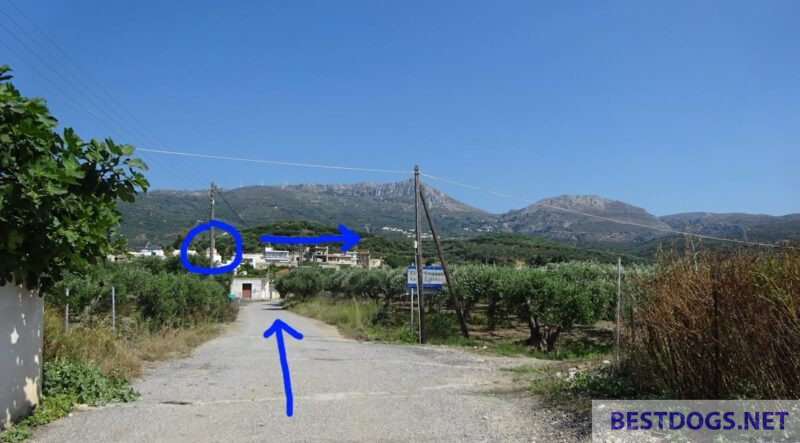
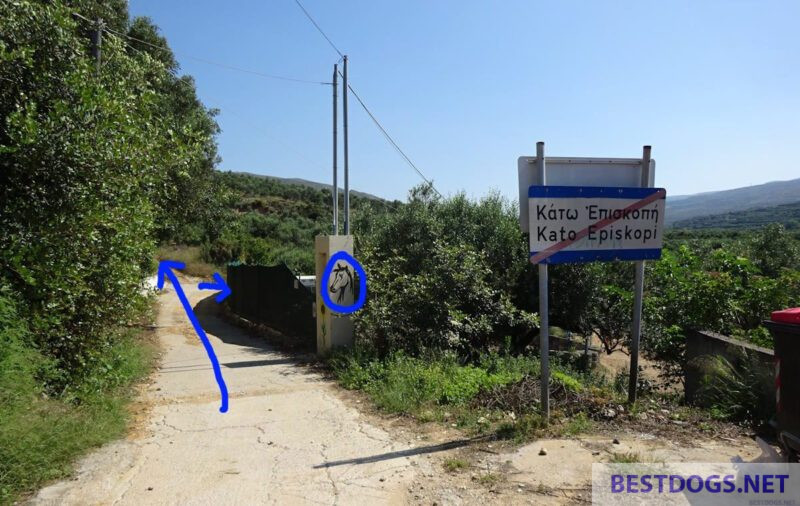
Link to Google Maps: Location of ‘With Horses in the Here and Now’
The myth of the horseshoe
This was possible because the ancient horse masters followed the principle that a horse should be housed in an environment where it would be ridden. According to Xenophon, a historian of the time, the horse stable should always be dry and covered with pebbles to harden the hooves. This was the best condition to conquer the world!
This weapon usually consists of four pointed iron spikes connected tetrahedrally. When thrown, three spikes remain on the ground and the fourth points upward. The Greeks called it ‘tetrahedron’ or ‘tribolos’ because of its resemblance to the plant Tribulus terrestis (earth-root thorn).
On ancient and medieval battlefields, numerous caltrops were distributed to stop, disperse and destroy enemy troops. When the galloping horse stepped on the caltrop, the pointed pin pierced the sole, the horse was immediately paralyzed and the rider was often thrown to the ground or had to continue fighting on foot.
If you imagine a puncture wound by a rusty iron, the horse was certainly finished with the medicine of the time and soldiers were also mostly incapacitated.
Before the modern nailed horseshoe was invented around the 11th century, there were many forms of horseshoes. All were temporarily, rather than permanently, attached to the horse, making them more similar in form and application to the modern horseshoe.
The most popular was the ‘hippo sandal’, a type of iron capsule with a flat sole that was attached to the horse’s leg with leather straps. Their shape, as well as their short-term applicability, suggests that these shoes were used only when there was a danger of stepping on caltrops on the battlefield or during a suspected ambush.
This means that, contrary to popular belief, these ancient horseshoes were not invented to protect the hoof from excessive wear, but were a military protective measure. However, another group of scientists suspects that they were used only for medical purposes while the horse was in the stable.
Horses today are actually only shod with horseshoes because the contemporary rider supposedly has special requirements. This is nonsense, however, as today’s horse could not have remotely withstood the demands of the ancient warriors.
Today we often have to deal with weak and frail horses, which have adapted from birth to a comfortable and gentle lifestyle. Confinement, lack of stimuli, unhealthy diet, untrained and unbalanced riders – all this adds up and eventually leads to weakness and pathology.
The problem is not so much the horse work, but the absurd contrast between the inadequate lifestyle and the expected athletic performance.
We have reached a point where the modern horse cannot even walk on soft sand or a grassy paddock without being shod!
Today’s shoeing is no longer about providing support and comfort, but a ploy to disguise insufficient pathology. If a horse is only sound when shod, then that horse cannot be sound and the shoes are merely used as crutches or band-aids to make an unhealthy horse perform serviceably.
(According to a note by Stavros Voutsas)
That is why Andrea’s horses on her farm ‘With Horses in the Here and Now’ are all not shod with horseshoes.
